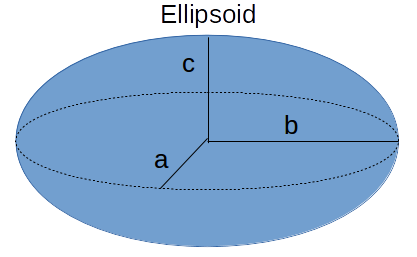The Volume of an Ellipsoid formula, V = 4/3⋅π⋅a⋅b⋅c, computes the volume of an ellipsoid with semi-axes of lengths a, b, and c.
INSTRUCTIONS: Choose units and enter the following:
- (a) semi-axis a.
- (b) semi-axis b.
- (c) semi-axis c.
Volume of an Ellipsoid (V): The volume of the ellipsoid (v) is returned in cubic meters. However, the volume can be automatically converted to other volume units (e.g. cubic feet, gallons, barrels) via the pull-down menu.
The Math / Science
The formula for the volume of an ellipsoid is as follows:
V = 4/3⋅π⋅a⋅b⋅c
where:
- V is the volume of the ellipsoid
- a, b and c are the lengths of the semi-axes
An ellipsoid is the most general shape in the class that includes:
- ellipsoid
- oblate spheroid
- sphere
Note that in each progressing case the number of axes with different lengths reduces from 3 in an ellipsoid, to 2 in an oblate spheroid, to one uniform radius in a sphere. Note that this formula is the equivalent to the volume of a sphere:
V = 4/3⋅π⋅a⋅b⋅c
V = 4/3⋅π⋅a⋅a⋅a
V = 4/3⋅π⋅a3 where a is the radius (r) of the sphere.
Ellipsoid Calculator
Ellipsoid - Volume computes the volume of an ellipsoid based on the length of the three semi-axes (a, b, c)
- Ellipsoid - Surface Area computes the surface area of an ellipsoid based on the length of the three semi-axes (a, b, c)
- Ellipsoid - Mass or Weight computes the mass or weight of an ellipsoid based on the length of the three semi-axes (a, b, c) and the mean density.
- Ellipsoid Cap - Volume computes the volume of a section of an ellipsoid.
- Oblate Spheroid - Volume computes the volume of an Oblate Spheroid based on the length of the two semi-axes (b, c)
- Oblate Spheroid- Surface Area computes the surface area of an Oblate Spheroid based on the length of the two semi-axes (b, c)
- Oblate Spheroid- Mass or Weight computes the mass or weight of an Oblate Spheroid based on the length of the two semi-axes (b, c) and the mean density.
- Sphere - Volume computes the volume of a sphere based on the length of the radius (a)
- Sphere - Surface Area computes the surface area of a sphere based on the length of the radius (a)
- Sphere - Mass or Weight computes the mass or weight of a sphere based on the length of the radius (a) and the mean density.
- Circular - Volume: Computes the volume of a column with a circular top and bottom and vertical sides.
- Circular - Mass: Computes the mass/weight of circular volume based on its dimensions and mean density.
- Elliptical Volume: Computes the volume of a column with an elliptical top and bottom and vertical sides.
- Elliptical - Mass: Computes the mass/weight of an elliptical volume based on its dimensions and mean density.
- Ellipse Vertical Chord from Edge (VE): Computes the length of the vertical chord of an ellipse based on distance from the edge.
- Ellipse Vertical Chord from Center (VC): Computes the length of the vertical chord of an ellipse based on distance from the center.
- Ellipse Horizontal Chord from Edge (HE): Computes the length of the horizontal chord of an ellipse based on distance from the edge.
- Ellipse Horizontal Chord from Center (HC): Computes the length of the vertical chord of an ellipse based on distance from the center.
- Common Mean Density: Provides a lookup function to find the mean density of hundreds of materials (woods, metals, liquids, chemicals, food items, soils, and more)
Volume is a three dimensional measurement of the amount of space taken up by an object. Volume units are cubic measurements for solid objects such as cubic inches and cubic meters. Fluids have separate volume units such as liters, fluid ounces, cups, gallons, and barrel.
The volume of an object can measured by the liquid it displaces or be calculated by measuring its dimensions and applying those dimensions to a formula describing its shape. Many such calculations are available in the following list of calculators.
In many cases, the calculators are for a column with a geometric shaped base and vertical sides. One basic formula for volume is area times a Height when the volume has vertical sides.

Volume Calculators
- Volume from Area and Height
- Volume of a Cube
- Volume of a Box
- Volume of a Cone
- Volume of a Cone Frustum
- Volume of a Cylinder
- Volume of a Slanted Cylinder
- Volume of a Semicircle
- Volume of a Triangular
- Volume of a Quadrilateral
- Volume of a Pentagon
- Volume of a Hexagon
- Volume of a Heptagon
- Volume of a Octagon
- Volume of a Nonagon
- Volume of a Decagon
- Volume of a Hendecagon
- Volume of a Dodecagon
- Volume of a Paraboloid
- Volume of a Polygon based Pyramid
- Volume of a Pyramid Frustum
- Volume of a Sphere
- Volume of a Sphere Cap
- Volume of a Sphere Segment
- Volume of a Sphere Shell
- Volume of a Oblate Spheroid
- Volume of a Ellipsoid
- Volume of a Torus
- Volume of a Bottle
- Volume of a Chamfer
- Gasket Volume
